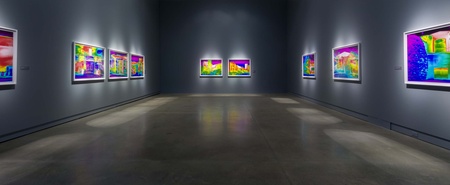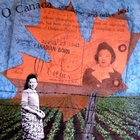I first met artist and professor Henry Tsang back in 2019 at the Powell Street Festival, where he was conducting 360 Riot Walk(ing) tours in the Paueru Gai/Nihonmachi area of Vancouver using iPads and images along the route that white rioters followed in a racist rampage through the Chinatown and Powell Street areas in 1907.
The tour is described as follows: “The Anti-Asian Riots were one of the most significant events in the history of Vancouver. 360 Riot Walk is an audio-visual experience that traces the history and route of the mob that attacked both the Chinese Canadian and Japanese Canadian communities following the demonstration and parade organized by the Asiatic Exclusion League in Vancouver. Immerse yourself in the social and political environment of the time when many communities were targeted through legislation as well as physical acts of exclusion and violence.”
When I saw a notice of an exhibition of Tsang’s newest exhibition, Hastings Park, at the Surrey Art Gallery in British Columbia, I was similarly intrigued. Sepia-toned images come immediately to mind of those large stone buildings filled with bunk beds, sheets hanging with the hope of privacy, the animal stalls where fastidious families were kept like livestock, stinking of manure, the mess hall, remembering stories of food poisoning, the fun young boys were having, the grimaces and looks of terror on the faces of adults, victims of senseless hate, torn from homes and businesses earned through a life of blood, sweat and tears, lives tossed into chaos and hysteria by a country blinded by racism.
There is something arresting and dreamy about the images Tsang captured: oddly pop arty, the pulsing aura of neon colours are otherworldly, summoning 1942 ghosts that haunt those buildings. “Hastings Park” was always a dirty word when I was growing up. As the location where Japanese Canadians were corralled before men, women and children were sent off to other places of imprisonment simply for being of Japanese descent. The historical significance for JCs imbues Tsang’s images with memories that are both mournful and meditative. Like our aging, fading parents, grandparents and grandparents who survived Hastings Park, those buildings have stories they are yearning to tell too, even after almost 80 years.
Hastings Park is a multimedia installation that we in eastern Canada deserve to see. It presents photographs and projections of four buildings at Hastings Park in Vancouver, where, in 1942, roughly 8,000 Japanese Canadians were marshalled and detained prior to being sent to internment and labour camps in the BC interior, Alberta, Manitoba, and Ontario. Among the four buildings is the Livestock Building — a place associated nowadays with the Pacific National Exhibition’s popular pig races and petting zoo.
Born in Hong Kong, Tsang is an associate professor at Emily Carr University of Art and Design in Vancouver. He received his MFA from the University of California, Irvine. I had the opportunity to interview him about the exhibition.
* * * * *
NI (Norm Ibuki): Creating images using thermal images of the buildings at Hastings Park is an interesting idea. How did it come about? How does the technology work?
HT (Henry Tsang): I had been wanting to work on a project about Hastings Park for some time, and an opportunity arose when I was commissioned by the Vancouver Heritage Foundation to create a photo mural for the CBC Wall (Canadian Broadcasting Corporation) in downtown Vancouver. As I wandered around the site considering the four remaining buildings from 1942, wondering how to make a photograph about that time, I recalled the heat-sensing camera that was used to analyze my home for energy efficiency (it turned out my house had no insulation). I was amazed by what that machine could see that we couldn’t, but our bodies could sense (like cold drafts).
Thermal imaging technology uses infrared scanners that measure the heat signatures of objects. It was developed through military research by the Americans during the Korean War. Thermal imaging can detect subtle differences in temperature, and is especially useful in exposing leaks and fissures that would signal issues with what is beneath the surface. It focuses on near-infrared wavelengths of light that human eyes are incapable of detecting. Besides the construction industry camera I used, other uses include surveillance, like security cameras, law enforcement, hunting in the dark, and self-driving vehicles, because they can “see” through fog and smoke. My intention was to use such a camera to see these buildings literally in a new light.
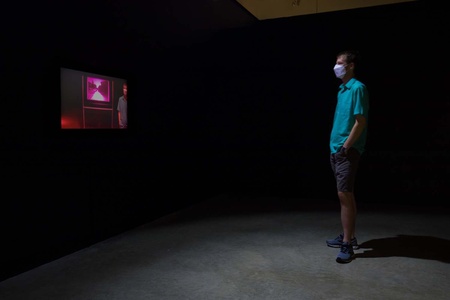
NI: How are the original four buildings being used today?
HT: There is a map from 1942 of the site showing the eleven buildings used to house the Japanese Canadians, with each assigned a different letter. There are four buildings still standing today: Building A, is known as the Livestock Building, was the Women and Children’s Dormitory; Building F, or Rollerland, was the Boys’ Dormitory; Building K, The Forum, was labelled “Unoccupied” on the map but functioned as the Men’s Dormitory; and Building L, the Garden Auditorium, was used as a school for the children and teenagers.
NI: You made an interesting comment in the exhibition’s YouTube video about the buildings having the ability to remember, can you please elaborate? How do those buildings “remember?”
HT: I used the thermal imaging camera as a medium through which I asked these buildings, “Do you remember the time when people lived inside you? If so, are there any traces left behind? What’s beneath your surface, if we go digging into your past? What else might we uncover?”
It sees in plain sight what we can’t. What evidence is there of the 8,000 folks who were forcibly removed from their homes and temporarily housed in the cattle stalls and hockey rink before being shipped off to internment and labour camps? What was retained, what was erased? It’s not like there’s a setting on these machines that can be set to look at 1942, but they do offer the ability to look for cracks on the surface of the official history of Vancouver, BC and Canada.
NI: The thermal images are somewhat ghostly…
HT: There’s definitely an energy to the images. The intensity of the saturated colours is somewhat jarring and creates a sense of oscillation, as if it’s a bit unstable. I’ve been told that someone, while looking at the photographs, heard children’s voices.
But the really ghostly images are those of the invisible projection which is installed in a separate room. It’s very dark, with one photograph seeming to glow on the wall. There’s an old slide projector automatically advancing slides that you can’t see with the naked eye until you approach the monitor on the opposite wall. There’s an infrared camera above the monitor aimed at a screen in the centre of the gallery, and it displays in real time the infrared projected slide image on that monitor. You can see yourself in that monitor in front of that invisible image, now made visible.
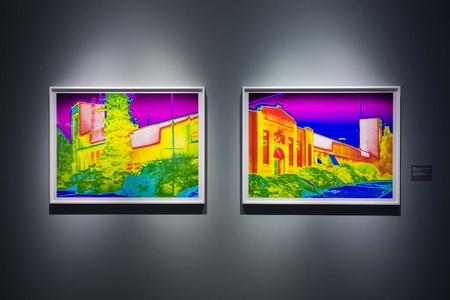
NI: What was revealed to you through the images? Any surprises? What is the hoped for take away that you have for viewers?
HT: I’m still discovering new things in the photographs, whether it’s the printed, colourful ones or the invisible ones being projected in the installation. What I’m trying to achieve is to create an embodied experience where the audience member is implicated within a space that recalls that historic event and/or socio-political condition. My hope is that these works collapse the past with the present.
NI: Can you please talk a bit about photographer Leonard Frank and his work related to the internment? How were those images curated with your own for this exhibition?
HT: Leonard Frank (1870-1944) was a prolific and successful local photographer who came out of retirement to document the forced relocation and internment of the Japanese Canadians for the BC Securities Commission during WWII. These are very important visual documents, and they are taken with a dispassionate eye, as they were for government purposes, not a personal photo essay or to make a political statement like Ansel Adams’ images of Manzanar in California. So I was aware of his series prior to my photo shoot with the thermal imaging camera, but I didn’t try to emulate them in any way. After my photo and video shoot, it became evident that some of my images were taken from the same spot where he stood back in 1942, which is uncanny because it certainly wasn’t planned. But then, there are only so many angles to shoot the buildings from, so maybe that shouldn’t have surprised me so much. And I only had four buildings to choose from as the others had all been demolished since then. In any case, it’s clear that my images are in conversation with Frank’s photographs, even if they are significantly different in approach and purpose.
NI: What kind of place does Hastings Park represent for Vancouverites these days? Is it a place that the city reflects much upon?
HT: Growing up in Vancouver, like others whose families were not interned during World War II, I wasn’t aware of how Hastings Park became the Processing Centre for Japanese Canadians prior to being sent off to labour and internment camps. My association with this place was that it was where the Pacific National Exhibition (PNE) took place every August with its baby pig races, livestock competitions, petting zoo, mini donuts, demolition derby, slice-and-dice devices and new home gadgets being hawked. And if we were lucky, my sister and I might get to buy some cotton candy and go on a few rides in Playland. It wasn’t until I was well into adulthood when I learned that it didn’t serve this function in 1942. And I was shocked. Why hadn’t this been taught to me in school? How could this not be considered important enough to be included in our educational curriculum? But this was normal in the 70s; it was the rare teacher, if any, who would broach topics such as the Chinese Head Tax or Chinese Exclusion Act, the residential school system, the Komagata Maru, the (white) race and (white) labour riots that rocked this city – after all, Vancouver was demographically much more white then, depending on the neighbourhood of course, and that would have made some white people uncomfortable to have to address these events and policies that affected some peoples’ lives more than others.
To its credit, but very much as a result of the hard work by engaged and committed activists, Vancouver has finally begun shifting toward acknowledging the inequalities constructed by our founding fathers and powers-that-be. It’s significant that Momiji Gardens was built at Hastings Park to commemorate the Japanese Canadian internment. Informational plaques around the site have since been installed. The Japanese Canadian Hastings Park Commemorative and Educational Project has been instrumental in raising awareness and producing educational material for use by teachers. And the Hastings Park 1942 website has been a terrific resource, one that I leaned on mightily in developing my art project.
As for jurisdiction, Hastings Park was controlled by the province until it recently handed ownership and management to the City of Vancouver. A few years back, the Hastings Park Master Plan was drafted, and there have been ongoing discussions on what its future might be.
NI: Who was Hastings Park named after?
HT: The south side of Hastings Park faces East Hastings Street, which is one of the important east-west traffic corridors in Vancouver. It used to be a part of Highway 7, since decommissioned, connecting Vancouver with the original western terminus of the Canadian Pacific Railway in Port Moody, prior to its move to Vancouver one year later in 1887. The street was formally named in 1885 for Rear-Admiral George Fowler Hastings of the British Royal Navy.
NI: What’s the takeaway message of the exhibition?
HT: I can’t answer that question; it’s an artwork, meaning it’s up to the audience to interpret it as they wish.
However, what I hope for is that the photographs and the invisible projection have an impact and create a visceral response in the viewer. And when introduced to, or confronted by the realization of the subject matter of what is being depicted – that these are buildings were used to entertain people, then to incarcerate a particular group of folks, then back to entertaining people – where does the viewer find themselves in that space between what their body perceives and what their mind is processing in terms of conceptual information? Is there a contradiction? Opposition? Dissonance? How does one navigate that divide?
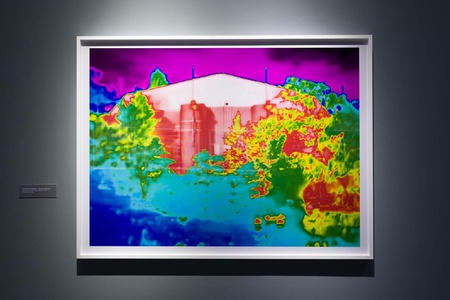
NI: As an Asian Canadian artist and educator, what else do you feel needs to be done to address ongoing intolerance and hate?
HT: I live on the unceded land of the Musqueam, Squamish and Tseil-Waututh and am humbled to have the privilege to call this place my home. But the conditions of this right are fraught. I think it’s my duty to learn about and attempt to understand how it is that I came here as a small child from Hong Kong, from one British colony to another, and what my relationship is with those around me and those before me. My children are fifth-generation British Columbians, and I’m very aware that their relationship to this place is significantly different than mine. And I’m also aware that, as a former immigrant, that I also bear some responsibility to those who have recently arrived, or those who will be coming here in the future to start a new life.
Hastings Park is one of various projects I have worked on that addresses racist attitudes and violence that is part of the legacy of the national, regional and local narratives. It’s crucial to learn about these injustices so we can identify and acknowledge what inequities have existed in our collective past and identify what still needs to be addressed.
© 2021 Norm Ibuki



